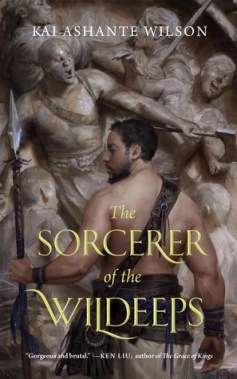
This post is the first of my transmissions from the science fiction and fantasy convention Eastercon, which ran from 14 to 17 April at the Birmingham Metropole. The post is a summary of an insightful conversation I and eight other fans/authors/publishers had with Lee Harris, the Hugo Award nominated Senior Editor at Tor.com.
Tor.com has been publishing short genre works for close on a decade. The company, which is separate from Tor UK, was set up when owner Macmillan decided to enter the short fiction market. The novella imprint was created with no books and no backlist in 2014, with its first publication being Kai Ashante Wilson’s extraordinary ‘The Sorcerer of the Wildeeps’. Despite expectations allowing for such a fresh start, the business made a profit in its first year and has continued to do so.
Tor.com also publish novels and novelettes; with Lee defining the latter as a work of fiction whose length is between that of a short story (up to 20,000 words) and a novella (up to 40,000 words). Anything above 40,000 words is a novel. However, 95% of Tor.com’s output is novellas and it publishes about four of them every month.
Lee maintains that the same elements which make a good novel make a good novella: good characters followed by a good plot. These elements and the form’s length ensure the novella is a quick read; even the longer ones (35,000 words and over), which have capacity for a sub-plot. Given that 70% of submitted works are rejected on the quality of the first page, it is worth mastering the form and managing expectations in the meantime.
Lee is a fan of effective pacing, citing Dan Browne as a master of the craft. Browne’s novels may not have what everyone looks for in literature, but his short chapters ending with cliffhangers, followed by a change in point of view in the following chapter have hooked more readers than many are willing to admit. However, novella series where every book ends in a cliffhanger are not favoured, as these are most likely novels that have been chopped up.
Publication can take a year, so any novellas accepted now would not be available to readers until next May. Tor.com prefers two books up front, although Lee admits that advances are modest. Authors have a choice of payment: an advance or no advance but higher royalties.
The agented/non-agented submission split tends to be about 50/50. The agented percentage helps ensure quality and a manageable workload, as does the specificity of story requirements during Tor.com’s occasional open submission opportunities. The most recent one requested fantasy novellas outside the Northern European tradition, with a three-month submission period. These restrictions enable Tor.com to provide openings for non-agented writers without being overwhelmed. Lee cites an example of an open submission when he worked at Angry Robot that yielded a staggering 900 books.
Tor.com tend to publish ebook novellas with some sold print on demand. These formats help control uneven production costs: for example, a printed novella is around 70p to produce, while a 900-page novel is just 10p more. Ebook sales in general have plateaued and are not about to replace printed books any time soon, but still account for a large market share. While the large publishing houses limit novella publication to one or two books a year, Tor.com’s approach ensures that short genre fiction is regularly available and affordable.

As a lover of short fiction, Lee is ideally placed to manage the complex process of its acquisition and publication. His career began when he set up a short story magazine called The Hub, which eventually went online and ran weekly for three years. One of The Hub’s subscribers was Marc Gascoigne, who in 2009 left Black Library to set up Angry Robot and who needed someone hands-on to assist. Lee, who at that time was working on statistical analysis at Xerox, took the job, moving to Tor.com five years later.
Lee describes a good editor as being a combination of project manager and salesman, with actual story editing only taking up between 7% and 10% of his time. His job is to find a story he loves and propose it, which involves putting together a profit and loss document including costs like acquisition, cover art and profit margin. The P&L document also makes clear who the book is by, what it is about and why it is right for Tor.com. The salesman role comes in convincing publishing executives that the book is worth investing money in; if the editor is not convincing then the project won’t work.
Lee approaches editing a text as if the author is a shipwright who builds the vessel while the editor watches from the dock. The editor is therefore best placed to see what sort of ship it is the author has planned. Refreshingly, there is not an expectation that it will be correct first time; the cabins may be in the wrong place or there may be overlooked holes that will become a problem at sea. All story elements need to be assembled sympathetically, but with a degree of objectivity.
The editor’s role is to assist in realising that vision, rather than turning the story into something they would have written. As with the writing itself, this is not a skill that can be taught; instead, it is a process that improves with each book.

